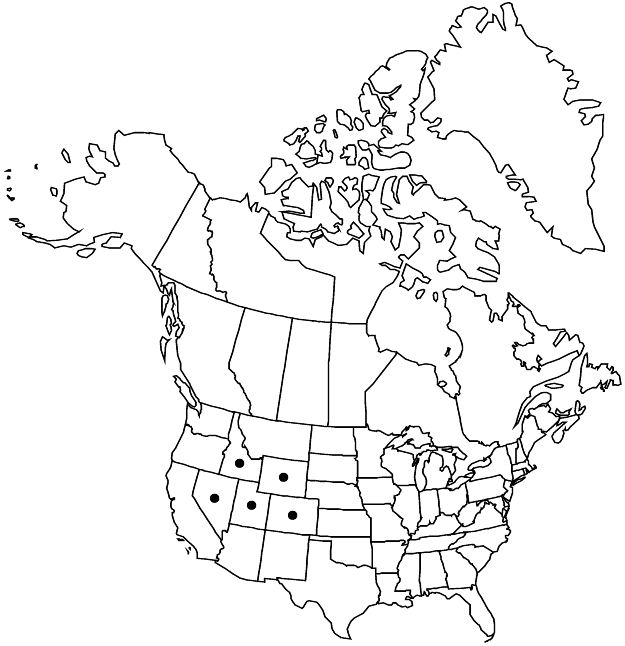Viola utahensis
Leafl. W. Bot. 5: 145. 1949.
Plants perennial, caulescent, not stoloniferous, 5–20 cm. Stems 1–4, prostrate, decumbent, or erect, leafy proximally and distally, glabrate or sparsely puberulent, on caudex from subligneous rhizome. Leaves basal and cauline; basal: 1–3; stipules adnate to petiole, forming 2 linear-lanceolate wings, margins entire or laciniate with glandular hairs, apex of each wing free, acute, sometimes divided into several filiform processes; petiole 2–8(–12) cm, glabrate or sparsely puberulent; blade usually broadly ovate, sometimes ± orbiculate, 1–4.5 × 0.7–3.4 cm, base usually attenuate, rarely truncate or subcordate, margins ± coarsely crenate-serrate, ciliate, apex obtuse, surfaces glabrate or sparsely puberulent; cauline similar to basal except: stipules lanceolate or linear-lanceolate to linear, margins ± entire or lacerate to laciniate with sparse gland-tipped projections, apex acute to acuminate, often divided into 2–4 filiform processes; petiole 3–8.7 cm; blade ovate to oblong-ovate or oblong-lanceolate, 0.7–1.6 × 2.6–3.7 cm, margins shallowly serrate, irregularly crenate, or ± entire, apex acute to obtuse. Peduncles 4–10 cm, glabrate or sparsely puberulent. Flowers: sepals lanceolate, margins ciliate or eciliate, auricles 1–1.5 mm; petals deep lemon-yellow adaxially, upper 2 and sometimes lateral 2 reddish brown to brownish purple abaxially, lower 3 and sometimes upper 2 dark brown-veined, lateral 2 sparsely bearded, lowest 10–13 mm, spur yellow, gibbous, 0.5–1.5 mm; style head bearded; cleistogamous flowers axillary. Capsules ± spherical, 6–7 mm, glabrous or finely puberulent. Seeds brown, ca. 3 mm. 2n = 24.
Phenology: Flowering May.
Habitat: Open sagebrush areas, semidesert slopes, grasslands, open forests
Elevation: 1200–2600 m
Distribution

Colo., Idaho, Nev., Utah, Wyo.
Discussion
Viola utahensis occurs only in areas where its closest relatives, V. vallicola and V. purpurea var. venosa, are also found and it appears to have originated from the crossing of those taxa followed by a doubling of the chromosomes (M. S. Baker 1949). The elaiosome of V. utahensis seeds has the same general appearance as those of other members of V. purpurea complex (except V. purpurea var. venosa), covering about one-third the length of the seed. G. Davidse (1976) found that tetraploid members of Clausen’s “subsect.” Purpurea (V. utahensis) have serrate leaf margins; diploid plants (V. purpurea) have crenate leaf margins. He also found that the size of V. utahensis plants is correlated with elevation, the largest plants at low elevations and the smallest at higher elevations.
G. Davidse (1976) reported putative hybrids between Viola utahensis and V. praemorsa subsp. major (= var. linguifolia), V. purpurea var. venosa, and V. beckwithii.
Observed pollinators of Viola utahensis in Utah include the bees Apis mellifera Linnaeus and Anthophora ursina Cresson (G. Davidse 1976). In other populations, flies in the genera Eristalis Latreille and Bombylius Linnaeus were observed indiscriminately visiting the yellow-flowered species V. praemorsa subsp. major, V. utahensis, and V. vallicola (Davidse).
Selected References
None.